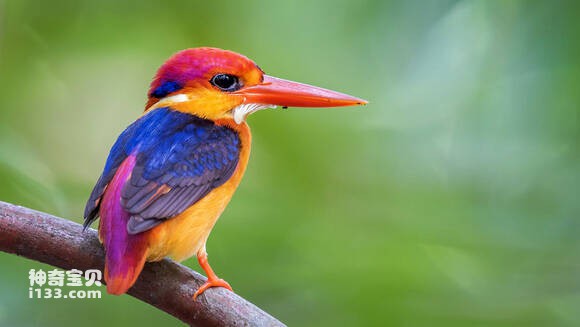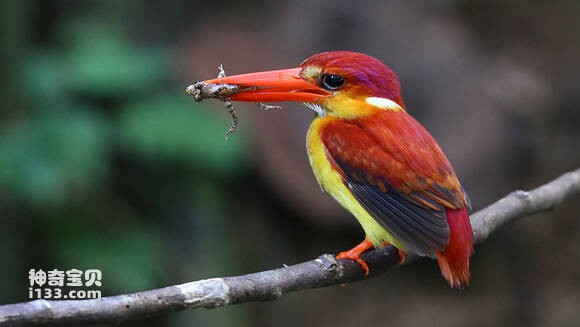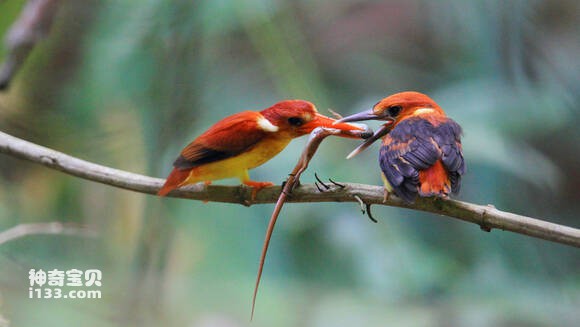Ceyx erithaca
IUCN
LCBasic Information
Scientific classification
- name:Ceyx erithaca
- Scientific Name:Ceyx erithaca,Three-toed Kingfisher
- Outline:Climbing birds
- Family:
Vital signs
- length:13-14CM
- Weight:14-20g
- lifetime:No textual research information is available
Feature
It has only three toes
Distribution and Habitat
The species is found in Bangladesh, Bhutan, Brunei Darussalam, Cambodia, China, India, Indonesia, Lao People's Democratic Republic, Malaysia, Myanmar, Philippines, Singapore, Sri Lanka, Thailand and Vietnam.
The three-toed kingfisher lives on the banks of streams and rivers in evergreen broad-leaved forests below 1500 meters above sea level, and is a typical forest streamside bird. It lives in evergreen primary forests and sub-forests. It is generally active in small hills or low height vegetation areas.
Appearance
The three-toed kingfisher is very small, 13-14 cm long, the male bird weighs 14-20 grams, and the female bird weighs 14-16 grams. It's a red and yellow kingfisher. The forehead is black; Head and neck orange-red; The shoulder feathers are grayish brown, and the tip of the feathers has a dark blue margin; Deep blue upper back; Lower back, waist, tail overlying feathers, tail feathers orange red, except tail feathers, other parts of the central purple, reflective. The wings are grayish brown. White chin; Throat light yolk white; Purplish red ear feathers, reflective; Under the mouth to the chest, abdomen, tail cover egg yellow, under the mouth to the chest, tail cover deeper, the abdomen is shallow. Iris brown; Red mouth and feet.
Only 3 digits; Tail shorter than mouth; Airfoil tip length; Feather color is not black and white. Mouth thick straight, long and firm, mouth ridge round; No nasal furrow; The wingtip is long, the first primary feathers are slightly shorter, and the thir
Details
The scientific name Ceyx erithaca, three-toed Kingfisher, has Three subspecies (1. The subspecies Ceyx erithacaerithaca is found in Bombay, southwest India, Sri Lanka, Bhutan, China (Yunnan, Hainan), Sumatra and neighboring islands. 2. Ceyx erithacamacrocarus, a subspecies of the three-toed kingfisher, is found in Andaman Islands, Nicobar Islands and Sumatra. 3. The Bornean subspecies Ceyx erithacamotleyi is found in the Philippines, Borneo, Java, Sumbawa, and Flores.

The three-toed kingfisher is a migratory bird. They migrate from August to September and return north in March. They hunt alone or in pairs. Sexual loneliness, usually live alone on the branches or rocks near the water, waiting for the opportunity to hunt, mainly to eat small fish, and eat crustaceans and a variety of aquatic insects and larvae, but also peck small frogs and a small number of aquatic plants. The low branches and reeds that often stop straight near the water also often stop on the rocks, waiting for the opportunity to hunt fish and shrimp, etc., after the kingfisher dives into the water, it can maintain excellent eyesight, because its eyes can quickly adjust the visual Angle contrast caused by the light in the water. So the kingfisher fishing ability is almost 100 percent, there is no false hair. Like most forest kingfishers, they are completely carnivorous. Often searching for prey in leaves or dirt. The main food is insects, locusts, flies and spiders, but also various aquatic animals such as water beetles, small crabs, frogs and small fish are eaten.
The three-toed kingfisher breeds in June in Sri Lanka, July to September in southwest India, April and May in northeast India, May in Malaysia, December to May in Java, and March in Sumatra. The nest is built on the earth cliff or on the embankment of the river, and the nest is dug in the tunnel type cave with the mouth. The depth is 25 cm, the width is 13-15 cm, and the diameter is 5-7 cm high. These caves are generally bare of bedding. The female lays three to seven eggs, which are laid directly on the nest ground. Some also drill holes in the tree trunks for nests, and the size of the eggs is 18-20 mm x 14-16 mm.

Listed on the International Union for Conservation of Nature (IUCN) 2013 Red List of Threatened Species ver 3.1 - Low Risk (LC).
Protect wild animals and eliminate wild meat.
Maintaining ecological balance is everyone's responsibility!








